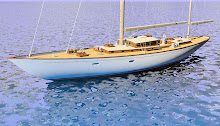
Keith Claybough positions walnut veneers on an epoxy coated plywood panel in preparation for clamping down the veneers by vacuum bagging as he makes a counter top for the owner's cabin.
Here are a couple of processes, vacuum bagging and making floorboards, that have been ongoing throughout the interior of the boat all winter and into the spring. There is rarely a day that, when we go home, the sound of a vacuum pump or two isn't running somewhere in the shop. And everyday for months a small crew of two guys have been gluing, grinding, vacuum bagging, sanding, trimming, routing, finishing and fitting the nearly black panels of the wenge floorboards that run throughout the boat.
Vacuum Bagging

After Keith tacked the veneers in place, so they they wouldn't slide around as pressure was applied, he covered the panel with a piece of blue pool cover then a piece of light green vacuum bagging plastic that is sealed all the around the edges to 1/8" thick butyl tape that had been applied to the work surface--in this case a piece of flake board--before gluing started. Before completely sealing around the bagging plastic, Keith inserts the hose that runs to the vacuum pump.

Keith then completely the seals "the bag," adding butyl tape over the top of the hose, then turns the pump on and pulls the air out. As the plastic pulls down tight, Keith checks all around the edges of the bag and the hose for leaks.
With a good vacuum the pressure on the surface of the veneers is 14 pounds per square inch, which doesn't sound like much but on this roughly two foot by three foot panel there is a total of just over 12,000 pounds of pressure.
The next day he'll take off the bag, scrape and sand off any excess epoxy, then trim the edges of the panel in preparation for the final treatment of the exposed edges and fitting in the boat.
Gluing veneers onto panels not only allows us to dress up structural members like bulkheads, such as the teak panels in the captain's cabin, but also allows us to make parts like counter tops and floorboards that will stay much flatter than their solid wood equivilents in the damp environment of a boat
Floor Boards

Making the floor boards starts with jointing and edge gluing together thick venners of wenge wood into panels a little bigger than the finished floorboard. Each floor board needs two of these veneer panels. Here blocks and wedges clamp the pieces of wood together while the lead weights on top keep the thin panel flat. After gluing the panels will be ground smooth.

Next the structural part of the floorboard is made from a special plywood with a sound dampening foam core that looks like black cork. The plywood is cut smaller than the finished floorboard and a groove routed all around the edges. Here Jimmy Hutchison and Richard Washburn insert wenge strips that have beeen machined with a tongue to fit into the grooves. The solid wood is clamped to the plywood with the same blocks and wedges that were used on the veneers.
Next the floorboard sandwich is made. First there is a veneer panel put down on a sheet of bagging plastic and its top surface coated with epoxy. Then the plywood panel is put on top and coated with epoxy. The last layer is the second veneer panel on top of the plywood. Over the panel goes either the pool plastic or sheet plastic and a special fabric called breather cloth, then the hose from the vacuum pump and finally the bagging plastic, which is twice the size of the floorboard, is folded back over the floorboard panel, the edges sealed with butyl tape, andthe pump started up.
 After the floorboard is cleaned up and sanded smooth it is marked for final size with the pattern made in the boat.
After the floorboard is cleaned up and sanded smooth it is marked for final size with the pattern made in the boat.
Here Jimmy trims the floorboard with a circular saw run along a straight edge to seperate the fixed part of the floorboard from the portion that will made to lift up for access into the bilge and the many hoses, wies and pipes below.

The floorboards are coated with urethane and labeled, then fitted in the boat, here in the passage between the main cabin and the aft cabin.

Finally, the floordoards are fitted with hardware such as hinges and hatch dogs.




